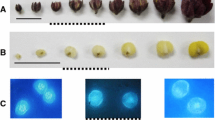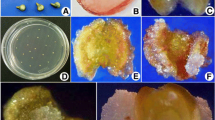Abstract
Androgenic haploids of the neem tree (Azadirachta indica A. Juss.) were produced by anther culture at the early- to late-uninucleate stage of pollen. Haploid formation occurred via callusing. The best medium for inducing callusing in the anther cultures was Murashige and Skoog's basal medium (MS) (9% sucrose) supplemented with 1 μM 2,4-D, 1 μM NAA and 5 μM BAP, while anther callus multiplied best on MS medium supplemented with 1 μM 2,4-D and 10 μM Kn. These calli differentiated shoots when transferred to a medium containing BAP; 5 μM BAP was optimum for young calli (75% cultures differentiated shoots), but older calli showed the best regeneration with 7.5 μM BAP. Shoots elongated at a lower concentration of BAP—0.5 μM. These shoots were multiplied by forced axillary branching and rooted in vitro. The plants were subsequently established in soil. Of the plants that regenerated from anther callus 60% were haploid, 20% were diploid and 20% were aneuploid.


Similar content being viewed by others
Abbreviations
- BAP :
-
6-Benzylaminopurine
- CH :
-
Casein hydrolysate
- 2,4-D :
-
2,4-Dichlorophenoxyacetic acid
- FAA :
-
Formalin acetic alcohol
- IBA :
-
Indole-3-butyric acid
- Kn :
-
Kinetin
- NAA :
-
α-Naphthaleneacetic acid
- TBA :
-
Tertiary-butyl-alcohol
References
Baldursson S, Ahuja MR (1996) Cytogenetics and potential of haploidy in forest tree genetics. In: Jain SM, Sopory SK, Veilleux RE (eds) In vitro production of haploids in higher plants. Fundamental aspects and methods, vol 1. Kluwer, Dordrecht, pp 49–66
Bhojwani SS, Razdan MK (1996) Plant tissue culture: theory and practice. Elsevier, Amsterdam
Chen ZH (1986) Induction of androgenesis in woody plants. In: Han H, Hongyuan Y (eds) Haploids of higher plants in vitro. China Academic, Beijing, pp 43–66
Govindachari TR, Sandhya G, Ganesh Raj SP (1992) Azadiractins H and I: two new tetranotriterpenoids from Azadirachta indica. J Nat Prod 55:596–601
Guha S, Maheshwari SC (1964) In vitro production of embryos from anthers of Datura. Nature 204:497
Höfer M, Touraev A, Herberle-Boss E (1999) Induction of embryogenesis from isolated apple microspores. Plant Cell Rep. 18:1012–1017
Murashige T, Skoog F (1962) A revised medium for rapid growth and bioassays with tobacco cultures. Physiol Plant 15:473–497
Pelletier G, Ilami M (1972) Les facteurs de làndrogenese in vitro chez Nicotiana tabacum. Z Pflanzenphysiol 68:97–114
Thengane S, Joshi M, Mascarenhas AF (1995) Somatic embryogenesis in neem (Azadirachta indica). In: Jain SM, Gupta P, Newton R (eds) Somatic embryogenesis in woody plants. Important selected plants, vol 2. Kluwer, Dordrecht, pp 357–374
Zhang XF, Liu YX, Lu ZH (1979) Cytological observation of the development of the microspore in poplar anther culture. J NE For Inst 2:5–13
Acknowledgements
Rakhi Chaturvedi thanks Professor S.P. Bhatnagar for his critical analysis of the manuscript and the Council for Scientific and Industrial Research (CSIR), India, for financial assistance.
Author information
Authors and Affiliations
Corresponding author
Additional information
Communicated by W. Harwood
Rights and permissions
About this article
Cite this article
Chaturvedi, R., Razdan, M.K. & Bhojwani, S.S. Production of haploids of neem (Azadirachta indica A. Juss.) by anther culture. Plant Cell Rep 21, 531–537 (2003). https://doi.org/10.1007/s00299-002-0565-6
Received:
Revised:
Accepted:
Published:
Issue Date:
DOI: https://doi.org/10.1007/s00299-002-0565-6




